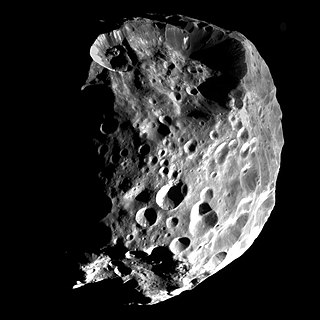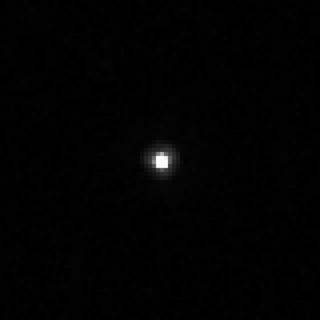
An impact crater is a depression in the surface of a solid astronomical body formed by the hypervelocity impact of a smaller object. In contrast to volcanic craters, which result from explosion or internal collapse, impact craters typically have raised rims and floors that are lower in elevation than the surrounding terrain. Impact craters are typically circular, though they can be elliptical in shape or even irregular due to events such as landslides. Impact craters range in size from microscopic craters seen on lunar rocks returned by the Apollo Program to simple bowl-shaped depressions and vast, complex, multi-ringed impact basins. Meteor Crater is a well-known example of a small impact crater on Earth.

Rhea is the second-largest moon of Saturn and the ninth-largest moon in the Solar System, with a surface area that is comparable to the area of Australia. It is the smallest body in the Solar System for which precise measurements have confirmed a shape consistent with hydrostatic equilibrium. Rhea has a nearly circular orbit around Saturn, but it is also tidally locked, like Saturn's other major moons; that is, it rotates with the same period it revolves (orbits), so one hemisphere always faces towards the planet.

Oberon, also designated Uranus IV, is the outermost and second-largest major moon of the planet Uranus. It is the second-most massive of the Uranian moons, and the tenth-largest moon in the Solar System. Discovered by William Herschel in 1787, Oberon is named after the mythical king of the fairies who appears as a character in Shakespeare's A Midsummer Night's Dream. Its orbit lies partially outside Uranus's magnetosphere.

Tethys, or Saturn III, is the fifth-largest moon of Saturn, measuring about 1,060 km (660 mi) across. It was discovered by Giovanni Domenico Cassini in 1684, and is named after the titan Tethys of Greek mythology.

Iapetus is the outermost of Saturn's large moons. With an estimated diameter of 1,469 km (913 mi), it is the third-largest moon of Saturn and the eleventh-largest in the Solar System. Named after the Titan Iapetus, the moon was discovered in 1671 by Giovanni Domenico Cassini.

Hyperion, also known as Saturn VII, is the eighth-largest moon of Saturn. It is distinguished by its highly irregular shape, chaotic rotation, low density, and its unusual sponge-like appearance. It was the first non-rounded moon to be discovered.

Phoebe is the most massive irregular satellite of Saturn with a mean diameter of 213 km (132 mi). It was discovered by William Henry Pickering on 18 March 1899 from photographic plates that had been taken by DeLisle Stewart starting on 16 August 1898 at the Boyden Station of the Carmen Alto Observatory near Arequipa, Peru. It was the first natural satellite to be discovered photographically.

Ariel is the fourth-largest moon of Uranus. Ariel orbits and rotates in the equatorial plane of Uranus, which is almost perpendicular to the orbit of Uranus, so the moon has an extreme seasonal cycle.

The moons of Saturn are numerous and diverse, ranging from tiny moonlets only tens of meters across to the enormous Titan, which is larger than the planet Mercury. There are 146 moons with confirmed orbits, the most of any planet in the solar system. This number does not include the many thousands of moonlets embedded within Saturn's dense rings, nor hundreds of possible kilometer-sized distant moons that have been observed on single occasions. Seven Saturnian moons are large enough to have collapsed into a relaxed, ellipsoidal shape, though only one or two of those, Titan and possibly Rhea, are currently in hydrostatic equilibrium. Three moons are particularly notable. Titan is the second-largest moon in the Solar System, with a nitrogen-rich Earth-like atmosphere and a landscape featuring river networks and hydrocarbon lakes. Enceladus emits jets of ice from its south-polar region and is covered in a deep layer of snow. Iapetus has contrasting black and white hemispheres as well as an extensive ridge of equatorial mountains among the tallest in the solar system.

(307261) 2002 MS4 (provisional designation 2002 MS4) is a large trans-Neptunian object in the Kuiper belt, which is a region of icy planetesimals beyond Neptune. It was discovered on 18 June 2002 by Chad Trujillo and Michael Brown during their search for bright, Pluto-sized Kuiper belt objects at Palomar Observatory. To within measurement uncertainties, 2002 MS4, 2002 AW197, and 2013 FY27 have a diameter close to 800 km (500 mi), which makes them the largest unnamed objects in the Solar System. 2002 MS4 is large enough that some astronomers conclude that it might be a dwarf planet.

Turgis is the largest known crater on Saturn's moon Iapetus. It is 580 km in diameter, 40% of the moon's diameter and one of the larger craters in the Solar System. It is named after a Saracen baron, Turgis of Turtelose (Tortosa).

Yangoor is the largest known impact crater on the surface of the Uranian moon Ariel. A central-peak impact crater, it is about 78 km in diameter and is located approximately 450 km from Ariel's south pole. The northwestern edge of the crater was erased by formation of ridged terrain. The crater lacks bright ejecta deposits and was imaged for the first time by the Voyager 2 spacecraft in January 1986. The crater is named after a spirit that brings day in Australian Aboriginal mythology. The name Yangoor was officially approved by the International Astronomical Union in 1988.

Belton Regio is a prominent surface feature of the dwarf planet Pluto. It is an elongated dark region along Pluto's equator, 2,990 km (1,860 mi) long and one of the darkest features on its surface.
Saragossa Terra is the name given to the southern part of the highly reflective half of Saturn's moon Iapetus. It is bordered on the north by Roncevaux Terra, and on both the east and west sides by Cassini Regio.

The equatorial ridge is the tallest mountain feature on Saturn's moon Iapetus. It is 20 km (12 mi) high, and is the third tallest mountain structure in the Solar System. It runs along most of Iapetus' equator. It was discovered by the Cassini probe in 2004. The ridge's origin is unknown. There are bright areas on the sides of the equatorial ridge near Iapetus' bright trailing hemisphere, which were already visible in Voyager 2 images appearing like mountains and were nicknamed the "Voyager Mountains".

Engelier is a 310-mile (500-kilometers) large crater on Saturn's moon Iapetus in Saragossa Terra. It partially obscures the slightly smaller crater Gerin.

Abisme /æˈbiːm/ is a large impact basin located in Cassini Regio at 37.5°N, 267.1°E. Craters Climborin, Clarin, Dapamort, Johun and Valdebron can be found inside Abisme. It was imaged for the first time by the Cassini spacecraft in 2004.















